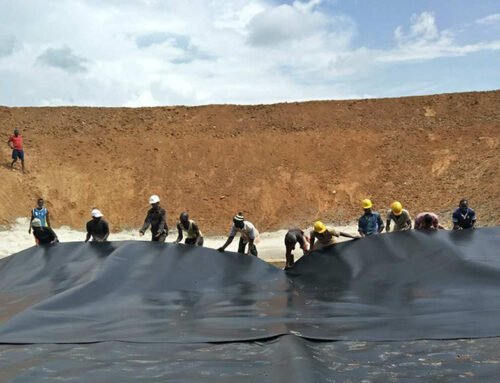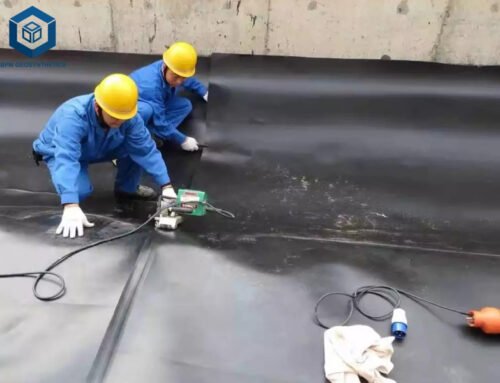LLDPE pond Liner and HDPE pond liner are the important geomembrane liners widely used for water and waste containment applications. When considering a geomembrane for a new containment project, it is common to question, LLDPE vs HDPE pond liner, which one is best suited for a specific purpose. The answer ultimately depends on the nature of the project, be it in agriculture, water management, construction, oil and gas, or as secondary containment. There is a wide range of options available, each with its own set of advantages and disadvantages, making them suitable for specific project requirements.
BPM is the leading geomembrane manufacturer and supplier with 16+ years of industrial experience, we wholesale geomembrane liner at great factory price. LLDPE pond Liner and HDPE pond liner have some similarities and differences in terms of chemical stability, aging resistance, environmental friendliness and constructability. By analyzing their physical properties, durability, cost vs. price, and application scenarios, In this article, let’s explore LLDPE vs HDPE pond liner, we hope it will help you find the right geomembrane liner for you specific projects.
1 Considerations to Choosing LLDPE vs HDPE Pond Liner
Selecting the appropriate geomembrane liner material is crucial for the stability and long-term benefits of pond construction, which plays a vital role in aquaculture and water quality maintenance. Two commonly used pond liner materials are LLDPE (Linear Low Density Polyethylene) and HDPE (High Density Polyethylene), each offering distinct advantages and suitability for specific scenarios.
LLDPE and HDPE pond liner have unique characteristics that make them suitable for different applications. LLDPE is known for its flexibility and puncture resistance, making it ideal for uneven or rocky terrains. It can conform to the shape of the pond and withstand potential damage. On the other hand, HDPE provides exceptional strength and durability, making it suitable for large-scale projects or areas prone to heavy loads or impacts.
Choosing between LLDPE vs HDPE pond liner depends on factors such as the pond size, terrain, expected loads, and budget. By considering these aspects, pond constructors can make an informed decision to ensure the optimal performance of the pond liner and maximize its long-term benefits.
2. What Are The Similarities of LLDPE pond Liner and HDPE pond liner
2.1 Chemical stability of LLDPE pond Liner and HDPE pond liner
LLDPE and HDPE pond liners are highly regarded for their excellent chemical stability. These liners exhibit impressive resistance to a wide range of substances, including organic solvents, acids, alkalis, and various salts. As a result, they are particularly well-suited for pond construction projects in chemical environments.
The chemical stability of LLDPE and HDPE pond liners ensures that they can withstand exposure to corrosive substances commonly found in chemical environments. This resistance is crucial for maintaining the integrity of the pond structure, preventing leakage or contamination that could harm aquatic life or compromise water quality.
When constructing ponds in chemical environments, the selection of a suitable liner material becomes vital. LLDPE and HDPE pond liners provide a reliable barrier against chemical substances, offering peace of mind to pond owners and operators. Their resistance to chemicals minimizes the risk of damage or deterioration, ensuring the long-term functionality and sustainability of the pond.
2.2 Aging resistance
Both LLDPE (Linear Low-Density Polyethylene) and HDPE (High-Density Polyethylene) pond liner materials are known for their excellent aging resistance. When exposed to the outdoor environment, these materials can effectively withstand natural factors such as ultraviolet (UV) rays, oxidation, and other environmental stresses, ensuring long-term stability and optimal performance.
UV resistance is a critical characteristic of LLDPE and HDPE pond liners. They are specifically formulated to withstand prolonged exposure to sunlight without significant degradation or loss of physical properties. This UV resistance prevents the liners from becoming brittle, cracking, or experiencing color fading, ensuring their durability and functionality over time.
Furthermore, both LLDPE and HDPE pond liners exhibit outstanding resistance to oxidation. They are designed to resist the damaging effects of oxygen exposure, which can lead to material degradation and loss of performance. This oxidation resistance enables the liners to maintain their structural integrity and performance even in harsh outdoor conditions.
The aging resistance of LLDPE and HDPE pond liners is a significant advantage, as it ensures their long-term stability and effectiveness in pond construction projects. By withstanding UV rays, oxidation, and other natural factors, these liners provide a reliable barrier that can endure and protect the pond for an extended period.
2.3 Environmental protection
LLDPE (Linear Low-Density Polyethylene) and HDPE (High-Density Polyethylene) liners are considered environmentally friendly materials due to their recyclability. This aligns with modern environmental protection principles and contributes to reducing the overall environmental impact.
Both LLDPE and HDPE can be recycled and processed into new products, mitigating the need for virgin plastic production. Recycling these liners helps conserve resources and reduce waste accumulation in landfills or natural environments. By promoting the circular economy, the recycling of LLDPE and HDPE liners supports sustainable practices and reduces the reliance on raw materials.
Additionally, the recyclability of LLDPE and HDPE liners aligns with the growing emphasis on environmental responsibility. It allows businesses and individuals to minimize their carbon footprint and contribute to a more sustainable future. By choosing environmentally friendly materials like LLDPE and HDPE liners, the negative impact on the environment can be reduced while still meeting project requirements.
It is important to note that proper recycling infrastructure and practices should be in place to ensure the effective recycling of LLDPE and HDPE liners. Collaboration between manufacturers, recyclers, and consumers is crucial for establishing efficient recycling systems and maximizing the environmental benefits of these materials.
Overall, the recyclability of LLDPE and HDPE liners reflects a commitment to environmental protection by reducing waste, conserving resources, and promoting sustainable practices. Incorporating these environmentally friendly materials in pond construction and other applications can contribute to a greener and more sustainable future.
2.4 Construction of LLDPE Pond Liner and HDPE pond liner
Both LLDPE and HDPE liner materials in the construction of a certain degree of convenience, LLDPE liner weldability is good, convenient construction connection. While the HDPE liner, although you need to use specialized welding equipment and technology, but before construction can be cut into different specifications of the sheet or roll, in order to adapt to different construction needs.
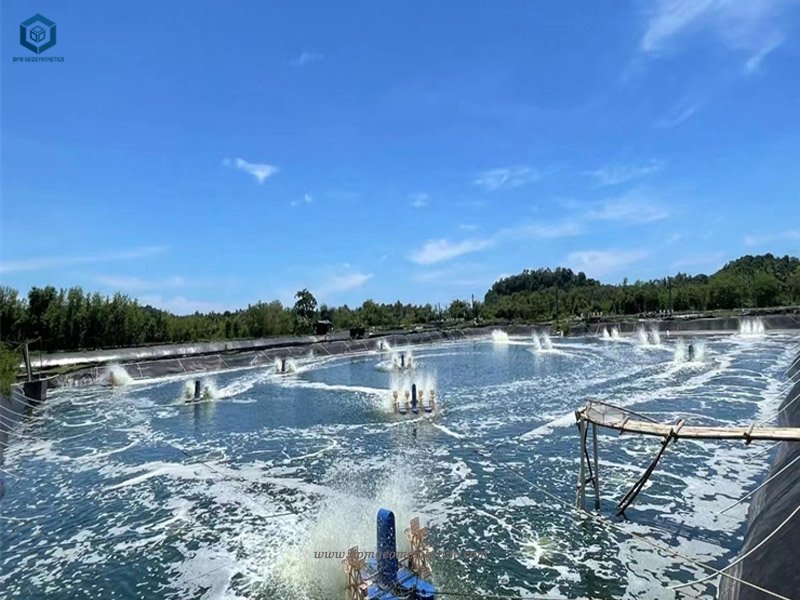
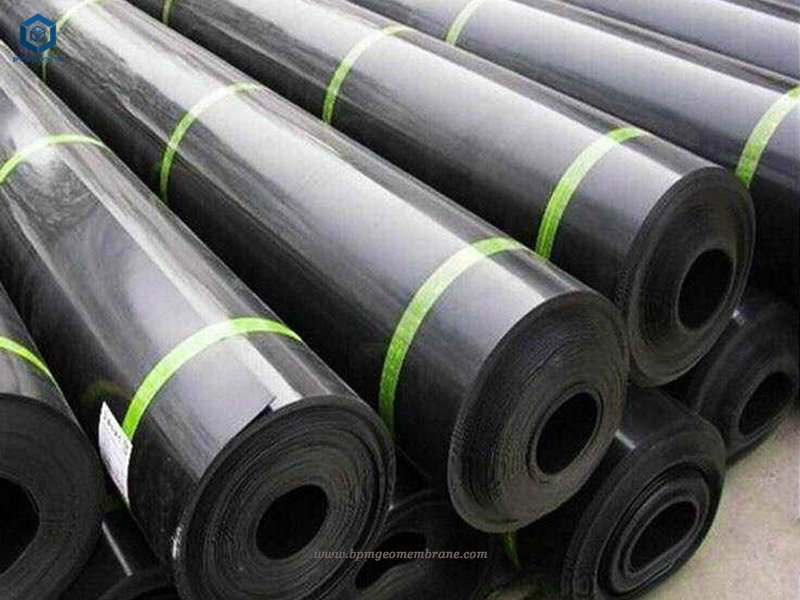
3 What Are The Differences Between LLDPE vs HDPE pond liner
3.1 Physical properties Between LLDPE vs HDPE pond liner
3.1.1 LLDPE Pond Liner
(1) Tensile Strength: LLDPE (Linear Low-Density Polyethylene) exhibits a high tensile strength, typically ranging between 20-30 MPa. This characteristic enables it to withstand the tensile forces exerted at the bottom of the pond, ensuring stability even when subjected to external pressures or forces.
(2) Flexibility: LLDPE possesses excellent flexibility, allowing it to accommodate minor deformations in the pond’s bottom. This inherent flexibility reduces the risk of cracks and damage, as the liner can adjust and conform to the contours of the pond bed. This flexibility is particularly beneficial in situations where the pond terrain may have irregularities or subtle variations.
The combination of LLDPE’s high tensile strength and flexibility makes it a suitable choice for pond liners. Its robust tensile strength enables it to withstand the demands placed on it, while its flexibility helps mitigate potential damage caused by shifts or slight movements in the pond’s foundation.
By utilizing LLDPE pond liners, pond constructors can ensure the long-term stability and integrity of the pond, minimizing the risk of leaks or structural failures. The tensile strength and flexibility of LLDPE contribute to its reliability and suitability for various pond construction projects.
3.1.2 HDPE Pond Liner
(1) Hardness: HDPE (High-Density Polyethylene) exhibits high hardness, typically ranging between 70-90 Shore hardness. This attribute provides better support properties and resistance to penetration by sharp objects, ensuring protection for fish and other organisms residing in the pond. HDPE geomembrane liners, such as the BPM brand, are manufactured using advanced production lines and three-layered pressing technology in accordance with GRI GM13 standards. Compared to traditional materials like concrete, asphalt, and compacted clay, HDPE geomembrane liners offer cost-effectiveness, environmental safety, excellent durability, chemical resistance, fast deployment, and easy transportation.
(2) Thickness: HDPE pond liners are commonly available in thicknesses ranging from 0.75mm to 3mm. This thickness range enables them to provide enhanced stability and durability to withstand various environmental conditions and potential stresses.
(3) Impact Resistance: HDPE exhibits superior impact resistance, allowing it to withstand external objects’ impact and abrasion. This quality ensures that the liner can endure potential physical forces without compromising its integrity or functionality.
The hardness, thickness, and impact resistance of HDPE pond liners make them a reliable choice for pond construction projects. The high hardness provides protection against punctures and sharp objects, while the appropriate thickness contributes to stability and longevity. Additionally, the impact resistance of HDPE ensures that the liner can withstand potential impacts and abrasions, maintaining its effectiveness over time.
3.2 Durability Between LLDPE vs HDPE pond liner
3.2.1 LLDPE Pond Liner
Environmental Stress Cracking Resistance: LLDPE (Linear Low-Density Polyethylene) demonstrates excellent resistance to environmental stress cracking. It is highly resistant to cracking and damage when exposed to environmental factors such as chemicals or physical stresses. The good tensile properties of LLDPE, coupled with its ability to resist environmental stress cracking, contribute to its long-term stability and performance in pond construction projects.
Aging Resistance: LLDPE pond liners possess exceptional aging resistance, allowing them to withstand the effects of natural factors in the outdoor environment. They can effectively resist the harmful effects of ultraviolet (UV) rays, oxidation, and other environmental factors that can degrade materials over time. The aging resistance of LLDPE ensures that the pond liner maintains its stability and performance over the long term, even when exposed to harsh outdoor conditions.
The environmental stress cracking resistance and aging resistance of LLDPE pond liners make them ideal for constructing durable and resilient ponds. Their ability to resist cracking, damage, and degradation from environmental factors ensures the long-term stability and functionality of the pond structure.
By utilizing LLDPE pond liners, pond constructors can have confidence in the liner’s ability to withstand the challenges posed by environmental stresses. The excellent environmental stress cracking resistance and aging resistance of LLDPE contribute to its suitability for pond construction in a variety of environments.
3.2.2 HDPE Pond Liner
(1) Chemical Resistance: HDPE (High-Density Polyethylene) offers excellent chemical resistance, making it well-suited for pond construction in chemical environments. It can withstand the erosion and degradation caused by various chemicals, making it suitable for ponds located near chemical plants or ponds that contain specific chemicals. The chemical resistance of HDPE ensures that the liner remains durable and maintains its integrity even when exposed to potentially corrosive substances.
(2) High Temperature Resistance: HDPE pond liners exhibit superior high temperature resistance, allowing them to maintain stability and durability in environments with elevated temperatures. The material’s high temperature stability ensures that it does not deform or lose its structural integrity when exposed to high temperatures. This quality makes HDPE suitable for applications in areas with high ambient temperatures, where other materials may not perform as effectively.
The chemical resistance and high temperature resistance of HDPE pond liners contribute to their reliability and suitability for various pond construction projects. The ability to resist chemical erosion and maintain stability in high temperature environments ensures the longevity and performance of the pond liner.
3.3 Cost and Price Between LLDPE vs HDPE pond liner
3.3.1 LLDPE Pond Liner
(1) Cost: LLDPE (Linear Low-Density Polyethylene) is known for being relatively inexpensive and cost-effective compared to other pond liner materials. This affordability makes it an ideal choice for large ponds or aquaculture ponds where a significant amount of material is needed to cover the pond area. The lower cost of LLDPE enables cost savings in pond construction projects without compromising the liner’s performance and durability.
(2) Weldability: LLDPE exhibits excellent weldability, which is advantageous during the construction process. The material can be easily welded together, facilitating connections and joints between different sections of the liner. This weldability not only simplifies the installation process but also helps reduce construction costs by minimizing the need for additional materials or complex installation techniques.
Furthermore, LLDPE pond liners possess good aging resistance, allowing them to maintain long-term stable performance. This aging resistance ensures that the liner retains its structural integrity and performance characteristics over time, contributing to the durability and reliability of the pond construction.
The cost-effectiveness and weldability of LLDPE pond liners make them a practical choice for various pond construction projects. The lower cost makes them suitable for large-scale applications, while the weldability simplifies installation and reduces construction expenses. Additionally, the aging resistance of LLDPE ensures the long-term stability and functionality of the pond liner.
3.3.2 HDPE Pond Liner
(1) Price: HDPE (High-Density Polyethylene) pond liners are generally more expensive compared to other options. However, this higher price is justified by their superior physical properties and durability. HDPE liners are an excellent investment for applications that require higher quality and long-term stability, such as small ponds or landscape ponds. Despite the higher initial cost, the durability and longevity of HDPE liners can provide significant cost savings over their lifespan. Geosynthetic manufacturers like GEOSINCERE strive to optimize production processes, ensuring that the costs of HDPE geomembrane liners are minimized to support clients and provide cost-effective solutions.
(2) Construction Requirements: HDPE pond liners require specialized welding equipment and techniques for construction connections. These connections ensure a watertight seal and maintain the integrity of the liner. While the welding process may require specific expertise, cutting HDPE into sheets or rolls of different sizes before construction allows for flexibility in adapting to various construction needs. This versatility in sizing enables customization and efficient installation according to the specific requirements of the pond project.
The higher price of HDPE pond liners is justified by their superior physical properties and durability, making them a worthwhile investment for projects that prioritize long-term stability and quality. The specialized welding requirements for HDPE liners ensure reliable connections, while the ability to customize the sizing enhances flexibility during installation.
3.4 Application Scenario
3.4.1 LLDPE Pond Liner
LLDPE (Linear Low-Density Polyethylene) pond liners are particularly suitable for application scenarios that demand high tensile strength, such as large ponds and aquaculture ponds. The inherent toughness and tensile strength of LLDPE liners offer improved protection and stability in these environments. The higher tensile strength helps the liner withstand potential stresses and strains, ensuring its long-term integrity and performance.
Furthermore, LLDPE pond liners are well-suited for application scenarios in cold regions due to their superior low-temperature stability. LLDPE exhibits good resistance to low temperatures, preventing it from becoming brittle or losing its physical properties in cold weather conditions. The low-temperature stability of LLDPE ensures that the liner maintains its flexibility and durability, even in freezing temperatures.
The high tensile strength and low-temperature stability of LLDPE pond liners make them an excellent choice for large ponds, aquaculture ponds, and cold regions. The enhanced protection, stability, and resilience provided by LLDPE liners ensure their reliability and longevity in demanding environments.
3.4.2 HDPE Pond Liner
It is suitable for application scenarios that require high hardness, impact resistance and durability, such as small ponds and landscape ponds. In these scenarios, the hardness and impact resistance of HDPE liner can provide better support and protection. In addition, HDPE liners are also suitable for application scenarios in high temperature areas because of their better high temperature stability. For example, HDPE is normally used for water conservancy projects such as wasterwater, artificial lakes and reservoirs. BPM HDPE geomembrane liner is blow molded by adding a certain proportion of carbon black masterbatch, anti-aging agent, antioxidant, ultraviolet absorber, stabilizer, etc. to polyethylene resin. In our project for New Zealand wastewater treatment, BPM engineers chose the 2mm thickness HDPE geomembrane and serve the project well. BPM polyethylene geomembrane conforms to various industry standards and laboratory quality consistency tests. All BPM HDPE geomembrane liner have passed ISO9001, ISO14001, TUV, Soncap, SASO, BV and other certifications, and passed SGS, Intertek and other tests.
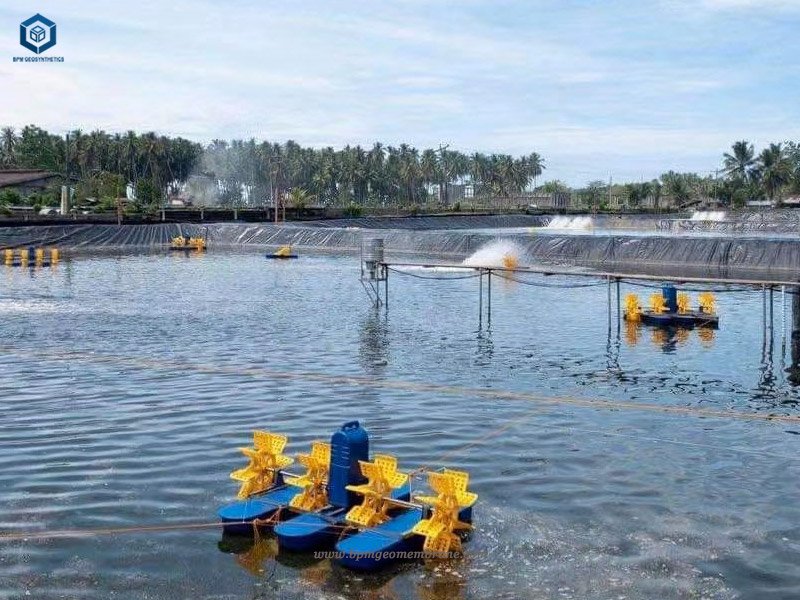
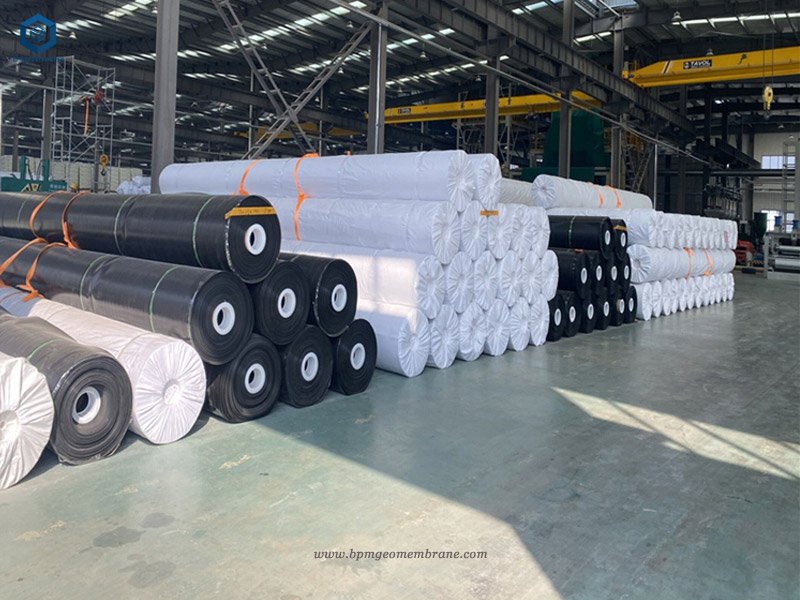
4 Conclusion
Both LLDPE and HDPE liners play an important role in pond construction. They differ significantly in terms of physical properties, durability, cost and price, and application scenarios to meet the specific needs of different pond types. However, both materials also have some things in common, such as good chemical stability, aging resistance, environmental friendliness, and constructability.
Whichever liner material is chosen, there is a need to ensure that its quality, durability and environmental performance meet the requirements to ensure the long-term stability of the pond and the success of the aquaculture. When selecting a liner material, factors such as pond type, usage requirements and budget should be considered in order to choose the most suitable liner material.
The choice of geomembrane for a containment project depends on the specific needs and objectives of the project. While HDPE and LLDPE are commonly recommended due to their excellent chemical resistance, it is essential to carefully assess all available options and consider the specific requirements of the project to ensure the most appropriate choice is made.
At BPM Geomembrane, we are the leading geomembrane manufacturer and suppliers for complete line of LLDPE geomembrane pond liner and HDPE pond liners
Welcome to contact us. Any questions and inquiries, please contact us.



